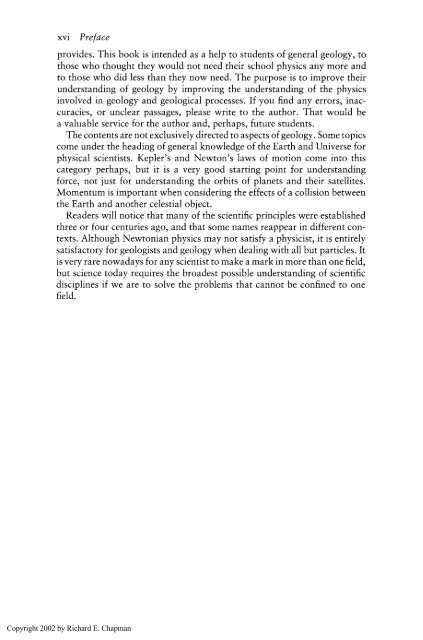Physics for Geologists, Second edition
Physics for Geologists, Second edition
Physics for Geologists, Second edition
Create successful ePaper yourself
Turn your PDF publications into a flip-book with our unique Google optimized e-Paper software.
xvi Preface<br />
provides. This book is intended as a help to students of general geology, to<br />
those who thought they would not need their school physics any more and<br />
to those who did less than they now need. The purpose is to improve their<br />
understanding of geology by improving the understanding of the physics<br />
involved in geology and geological processes. If you find any errors, inac-<br />
curacies, or unclear passages, please write to the author. That would be<br />
a valuable service <strong>for</strong> the author and, perhaps, future students.<br />
The contents are not exclusively directed to aspects of geology. Some topics<br />
come under the heading of general knowledge of the Earth and Universe <strong>for</strong><br />
physical scientists. Kepler's and Newton's laws of motion come into this<br />
category perhaps, but it is a very good starting point <strong>for</strong> understanding<br />
<strong>for</strong>ce, not just <strong>for</strong> understanding the orbits of planets and their satellites.<br />
Momentum is important when considering the effects of a collision between<br />
the Earth and another celestial object.<br />
Readers will notice that many of the scientific principles were established<br />
three or four centuries ago, and that some names reappear in different con-<br />
texts. Although Newtonian physics may not satisfy a physicist, it is entirely<br />
satisfactory <strong>for</strong> geologists and geology when dealing with all but particles. It<br />
is very rare nowadays <strong>for</strong> any scientist to make a mark in more than one field,<br />
but science today requires the broadest possible understanding of scientific<br />
disciplines if we are to solve the problems that cannot be confined to one<br />
field.<br />
Copyright 2002 by Richard E. Chapman






